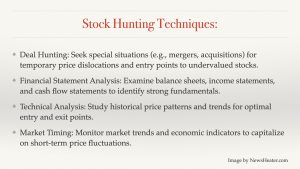Bargain hunting and value investing are investment strategies that focus on identifying undervalued stocks with the potential for significant growth. Bargain hunting typically involves seeking out stocks that are trading at a discount to their intrinsic value, while value investing aims to uncover fundamentally sound companies with strong prospects for long-term success.
These strategies have gained popularity among investors seeking to maximize returns while minimizing risks. By focusing on undervalued assets, investors can potentially achieve superior performance and protect their portfolios from market volatility.
Bargain hunters play a crucial role in the stock market by identifying inefficiencies and exploiting them for profit. They help to correct mispriced securities and contribute to more efficient and stable markets.
The Bargain Hunting Process
What is bargain hunting?
Bargain hunting refers to the practice of searching for stocks that are trading below their intrinsic value, offering investors the opportunity to buy them at a discount. This strategy is based on the belief that the market occasionally misprices assets, providing savvy investors with the chance to capitalize on these discrepancies.
While bargain hunting and value investing share some similarities, they differ in their approach. Bargain hunting is more short-term focused and opportunistic, while value investing is a long-term strategy that seeks to identify fundamentally strong companies with sustainable competitive advantages.
The mindset of a bargain hunter
A bargain hunter is an investor who actively searches for undervalued stocks in the market. They believe that, through diligent research and analysis, they can uncover hidden gems that the broader market has overlooked or undervalued.
Successful bargain hunters possess several traits, such as patience, discipline, and a strong analytical mindset. They are willing to dig deep into financial statements and market data to identify attractive investment opportunities. Additionally, they are contrarian by nature, often going against the prevailing market sentiment to find undervalued assets.
Stock hunting techniques

Deal hunting: Bargain hunters frequently scour the market for special situations such as mergers, acquisitions, spin-offs, or other corporate events that may create temporary price dislocations and offer attractive entry points for undervalued stocks.
Analyzing financial statements: A thorough examination of a company’s financial statements, including balance sheets, income statements, and cash flow statements, is essential for identifying undervalued stocks. Bargain hunters look for strong fundamentals, such as low debt levels, high cash reserves, and consistent earnings growth.
Technical analysis: Some bargain hunters employ technical analysis, studying historical price patterns and trends to determine entry and exit points for investments. This approach helps them identify potential buying opportunities based on historical support and resistance levels.
Market timing: While difficult to execute consistently, market timing can be a valuable tool for bargain hunters. By closely monitoring market trends and economic indicators, they attempt to capitalize on short-term price fluctuations and benefit from temporary market inefficiencies.
Value Investing: A Comprehensive Approach
Define value investing
Value investing is an investment strategy that involves selecting stocks with strong fundamentals, trading at a discount to their intrinsic value. This approach, pioneered by Benjamin Graham and further popularized by Warren Buffett, emphasizes the importance of a long-term perspective and a focus on the underlying business rather than short-term market fluctuations.
Key principles of value investing include margin of safety, intrinsic value estimation, and a focus on the quality of the underlying business.
Value investing example
A classic example of successful value investing is Warren Buffett’s investment in Coca-Cola in the late 1980s. At the time, the company was experiencing temporary challenges, but Buffett recognized its strong brand and competitive advantages, leading him to invest heavily in the stock. This investment has since delivered significant returns for Berkshire Hathaway shareholders.
Lessons from this example include the importance of focusing on the long-term prospects of a business, the power of strong brands, and the value of a contrarian mindset when identifying investment opportunities.
Value hunter strategies
Margin of safety: Value investors always seek to purchase stocks with a margin of safety, which means buying them at a price that is significantly below their intrinsic value. This approach minimizes the downside risk and increases the potential for capital appreciation.
Intrinsic value estimation: Estimating a company’s intrinsic value is a critical skill for value investors. This involves assessing the company’s financial health, competitive position, management quality, and growth prospects, among other factors.
Diversification: A well-diversified portfolio can help mitigate risks and enhance returns over the long term. Value investors typically invest in a range of sectors and industries to reduce the impact of adverse events affecting individual companies or industries.
Tools and Metrics for Bargain Hunters and Value Investors
Financial ratios
- Price-to-earnings (P/E) ratio: The P/E ratio is a valuation metric that compares a company’s current market price to its earnings per share. A lower P/E ratio may indicate that a stock is undervalued relative to its earnings potential.
- Price-to-book (P/B) ratio: The P/B ratio compares a company’s market price to its book value (total assets minus total liabilities). A lower P/B ratio may signify an undervalued stock.
- Dividend yield: Dividend yield is the annual dividend payment divided by the stock’s market price. A higher dividend yield can indicate a potentially undervalued stock and may provide income to investors during market downturns.
- SPY PEG ratio: The price/earnings to growth (PEG) ratio is used to determine a stock’s value while taking into account the company’s earnings growth. The SPY PEG ratio compares the P/E ratio of the S&P 500 index to its expected earnings growth rate. A lower SPY PEG ratio can indicate that the overall market is undervalued relative to its growth potential.
Stock screening tools
- Online platforms and software: Various online platforms and software tools are available for investors to screen for undervalued stocks based on predefined criteria, such as financial ratios, industry, and market capitalization.
- Customizing screens for bargain hunting and value investing: Investors can customize stock screens to suit their unique investment strategies, focusing on specific financial metrics, industry trends, or other factors that align with their investment objectives.
Identifying Stock Bargains and Avoiding Value Traps
Stock market bargains
Characteristics of bargain stocks: Bargain stocks often exhibit strong fundamentals, such as low debt levels, healthy cash flows, and consistent earnings growth. They may also be temporarily out of favor with the market due to short-term challenges or negative sentiment.
How to find and evaluate stock bargains: Investors can utilize stock screening tools and conduct thorough research and analysis of financial statements, industry trends, and macroeconomic factors to identify and evaluate potential stock bargains.
Value Traps and Bargain Hunters Beware
Definition and examples of value traps: A value trap occurs when a stock appears to be undervalued but is actually priced appropriately due to underlying issues, such as deteriorating fundamentals, declining market share, or weak management. Examples of value traps can include companies facing industry disruptions or those with unsustainable business models.
Strategies to avoid falling into value traps: To avoid value traps, investors should thoroughly analyze a company’s financial health, competitive position, and growth prospects. Additionally, they should maintain a long-term perspective and be prepared to cut losses if the company’s situation worsens.
Signs of a potential value trap: Red flags that may indicate a potential value trap include declining revenue or earnings, increasing debt levels, or a history of management missteps.
Conclusion
The benefits and challenges of bargain hunting and value investing: Both bargain hunting and value investing can offer attractive returns for investors who are willing to conduct thorough research and maintain a disciplined approach. However, these strategies also require patience and a long-term perspective, as well as the ability to withstand short-term market fluctuations.
The importance of continuous learning and adapting: Successful investors constantly learn from their experiences and adapt their strategies to stay ahead of changing market conditions. This includes refining their stock selection criteria, staying informed about industry trends, and embracing new tools and technologies.
Encouragement for investors to develop their own investment strategies: While bargain hunting and value investing are proven strategies, individual investors should develop their own unique approach based on their risk tolerance, investment objectives, and personal interests. By cultivating a personalized investment strategy, investors can increase their chances of long-term success in the stock market.






